Excerpts from Jim Conrad's
Naturalist Newsletter
from the November 9, 2014 Newsletter issued from Río Lagartos, on the Yucatan Peninsula's northern coast (~N21.60°, ~W88.16°), Yucatán state, MÉXICO
SWEET MANGROVE
A lot of the plants and animals in the Río Lagartos area are new to me. Still, normally I can recognize what family a new-to-me flowering plant belongs to, and often even the genus, which helps a lot during the identification process. However, sometimes something comes along that simply throws me for a loop, maybe by mingling features that I'd thought were to be found only in different plant families. That was the case with a certain belly-high, evergreen shrub growing in salt-saturated sand of what might have been an ancient dune along the coast just east of Río Lagartos, shown below being photographed by my friend Jim Legault:
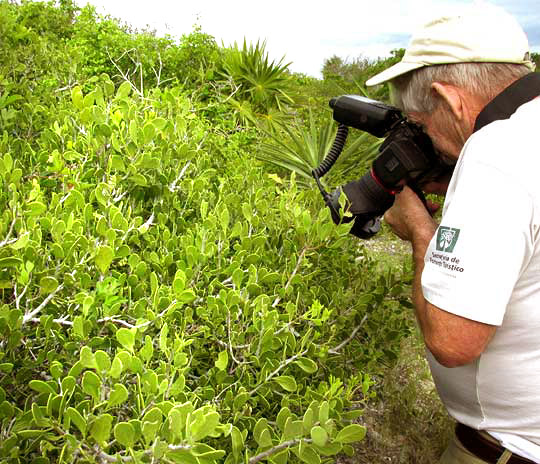
The sand's high salt content manifested itself in the bush's growth form, for the bush's stems and leaves were fairly succulent, succulence being a water-retaining feature of many plants adapted for very dry and/or salty conditions -- plants that are "halophytes." The chewed leaves had a definite salty taste. A branch of the plant is shown below:
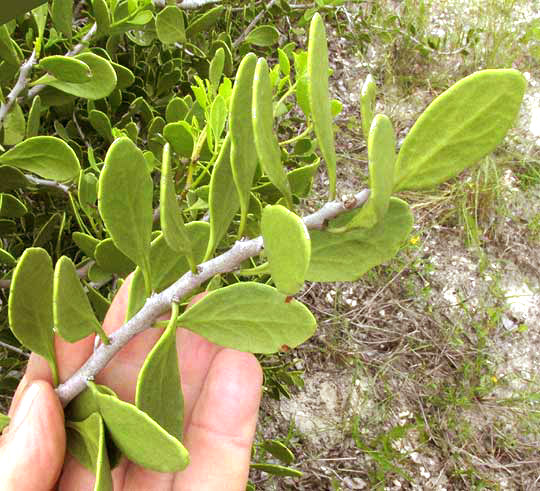
A picture of the unusual, green flowers, with some kind of glistening exudation -- probably nectar -- beaded atop a doughnut-like disk surrounding the base of the plump ovary is shown below:
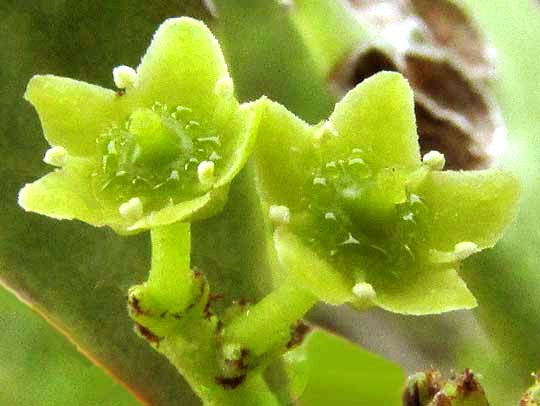
The bush bore pea-sized, capsule-type fruits about to turn red, shown below:
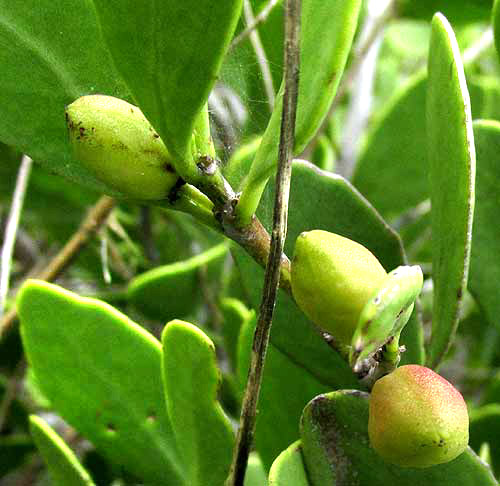
Some branches bore remains of capsules that earlier had split open, allowing the seeds to escape, and remained on the stems looking like tiny, brown flowers, as shown below:
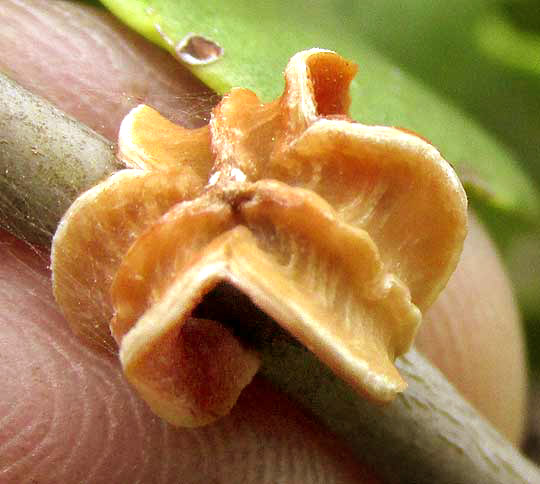
Still, the strange blossoms interested me most, for they reminded me of flowers seen last year in southwestern Texas on a Hog Plum tree belonging to the Buckthorn Family, the Rhamnaceae and the genus Colubrina. You can compare our flower photo with a Hog Plum flower in Texas at www.backyardnature.net/n/13/130519rj.jpg.
The most obvious difference between the two flowers is that the Hog Plum blossom in Texas bears tiny, green petals, but our Río Lagartos plant's flowers have none, just petal-like calyx sepals. That difference didn't keep me from assuming that we had a member of the Buckthorn Family, though. The problem was that no plant in the Buckthorn Family listed for the Yucatan bears such flowers on a shrub with succulent twigs and leaves.
Fortunately as I was banging my head against this plant's elusive identity I happened to be in communication with botanists at CICY, the Centro de Investigación Científica de Yucatán, in Mérida -- the Center for Scientific Study of Yucatán. An expert there was kind enough to identify our Río Lagartos bush as MAYTENUS PHYLLANTHOIDES, known as Sweet Mangrove, Mangle Dulce, Mayten, Florida Mayten, Gutta-percha Mayten, Leatherleaf and by other names. It's a member of the Staff-Tree or Bittersweet Family, the Celastraceae, which also includes the Hearts-a-bustin' or Strawberry Bush, Euonymus americanus, we had back in Mississippi. The Hearts-a-bustin' green flowers also had a doughnut-like disk at the base of the flower's ovary, and no petals, as shown at www.backyardnature.net/n/09/090406ev.jpg.
That picture shows that blossoms of Hearts-a-bustin' and Sweet Mangrove are very similar structurally. I should have recognized the similarities, but I just didn't. If you want to see the Hearts-a-bustin' plant, which you'll probably recognize when you see it, it's profiled at www.backyardnature.net/n/w/euonymus.htm.
Sweet Mangrove isn't common enough to be considered one of the four species thought of as constituting the Yucatan's mangrove ecosystem. The bush is distributed along the coasts of Florida and southern Texas, but mostly it's a Mexican plant, occurring on both the Pacific and Gulf coasts. The online Atlas de las Plantas de la Medicina Tradicional Mexicana reports that besides living in the vicinity of mangrove swamps, Sweet Mangrove can be found in a variety of dry soil situations, including oak forests.
The Atlas also says that leaves, roots and bark of Sweet Mangrove have been used in traditional medicine against "rheumatism," which probably is arthritis. Boil the leaves and stems for about an hour, let the resulting tea cool off, add a little alcohol, and massage the liquid onto painful joints. Add some cinnamon and it's also good for the kidneys.